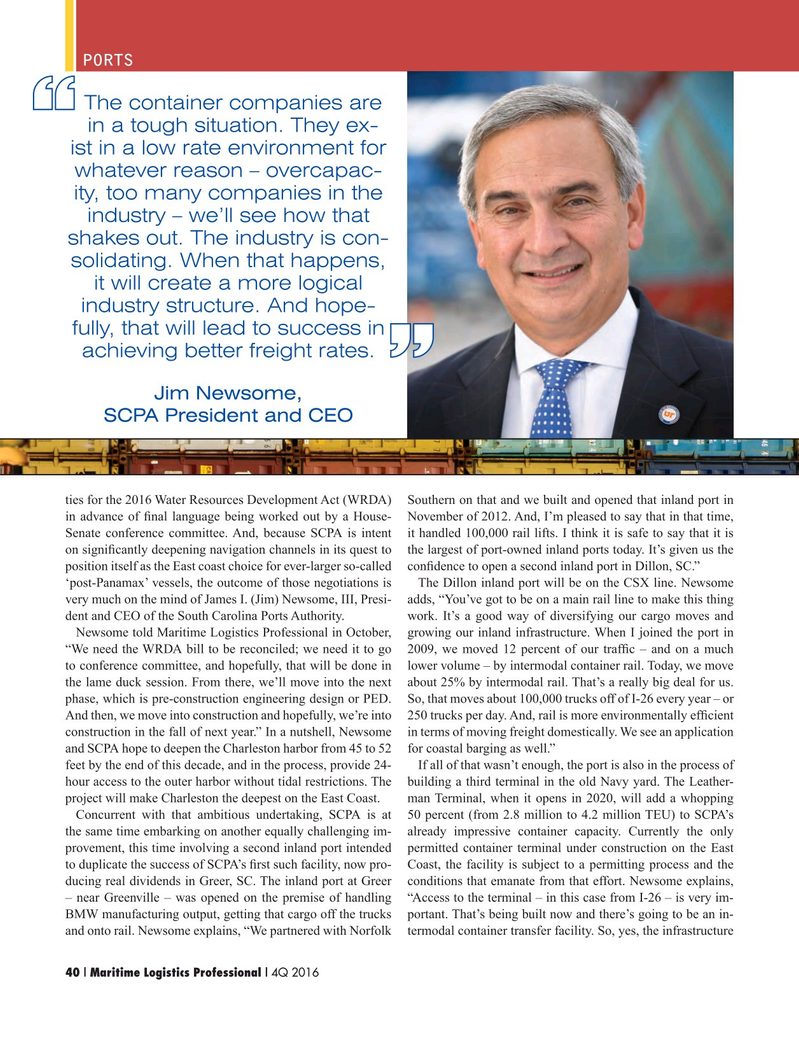
Page 40: of Maritime Logistics Professional Magazine (Q4 2016)
Workboats
Read this page in Pdf, Flash or Html5 edition of Q4 2016 Maritime Logistics Professional Magazine
PORTS
The container companies are in a tough situation. They ex- ist in a low rate environment for whatever reason – overcapac- ity, too many companies in the industry – we’ll see how that shakes out. The industry is con- solidating. When that happens, it will create a more logical industry structure. And hope- fully, that will lead to success in achieving better freight rates.
Jim Newsome,
SCPA President and CEO ties for the 2016 Water Resources Development Act (WRDA) Southern on that and we built and opened that inland port in in advance of ? nal language being worked out by a House- November of 2012. And, I’m pleased to say that in that time,
Senate conference committee. And, because SCPA is intent it handled 100,000 rail lifts. I think it is safe to say that it is on signi? cantly deepening navigation channels in its quest to the largest of port-owned inland ports today. It’s given us the position itself as the East coast choice for ever-larger so-called con? dence to open a second inland port in Dillon, SC.” ‘post-Panamax’ vessels, the outcome of those negotiations is The Dillon inland port will be on the CSX line. Newsome very much on the mind of James I. (Jim) Newsome, III, Presi- adds, “You’ve got to be on a main rail line to make this thing dent and CEO of the South Carolina Ports Authority. work. It’s a good way of diversifying our cargo moves and
Newsome told Maritime Logistics Professional in October, growing our inland infrastructure. When I joined the port in “We need the WRDA bill to be reconciled; we need it to go 2009, we moved 12 percent of our traf? c – and on a much to conference committee, and hopefully, that will be done in lower volume – by intermodal container rail. Today, we move the lame duck session. From there, we’ll move into the next about 25% by intermodal rail. That’s a really big deal for us. phase, which is pre-construction engineering design or PED. So, that moves about 100,000 trucks off of I-26 every year – or
And then, we move into construction and hopefully, we’re into 250 trucks per day. And, rail is more environmentally ef? cient construction in the fall of next year.” In a nutshell, Newsome in terms of moving freight domestically. We see an application and SCPA hope to deepen the Charleston harbor from 45 to 52 for coastal barging as well.” feet by the end of this decade, and in the process, provide 24- If all of that wasn’t enough, the port is also in the process of hour access to the outer harbor without tidal restrictions. The building a third terminal in the old Navy yard. The Leather- project will make Charleston the deepest on the East Coast. man Terminal, when it opens in 2020, will add a whopping
Concurrent with that ambitious undertaking, SCPA is at 50 percent (from 2.8 million to 4.2 million TEU) to SCPA’s the same time embarking on another equally challenging im- already impressive container capacity. Currently the only provement, this time involving a second inland port intended permitted container terminal under construction on the East to duplicate the success of SCPA’s ? rst such facility, now pro- Coast, the facility is subject to a permitting process and the ducing real dividends in Greer, SC. The inland port at Greer conditions that emanate from that effort. Newsome explains, – near Greenville – was opened on the premise of handling “Access to the terminal – in this case from I-26 – is very im-
BMW manufacturing output, getting that cargo off the trucks portant. That’s being built now and there’s going to be an in- and onto rail. Newsome explains, “We partnered with Norfolk termodal container transfer facility. So, yes, the infrastructure 40 | Maritime Logistics Professional | 4Q 2016 34-49 Q4 MP2016.indd 40 11/9/2016 12:22:07 PM

 39
39

 41
41
